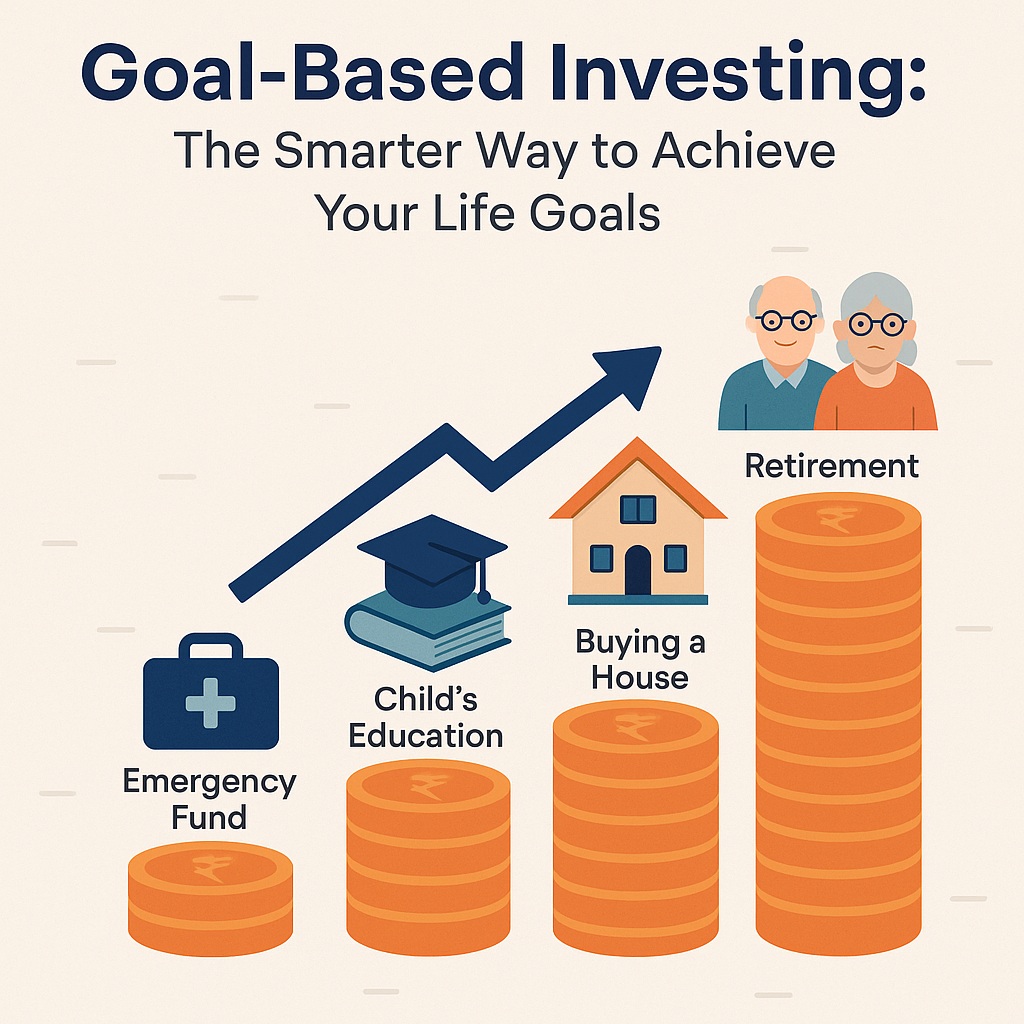- +91 9406205550
-



Most people invest for the sake of investing. Some chase returns, some follow the crowd, and many simply save without clarity on what the money is meant to do. But wealth without purpose can become a wasted opportunity.
Enter Goal-Based Investing—a more meaningful, structured, and intentional approach to managing your money. Instead of asking, “Where should I invest?”, you begin with “Why am I investing?”
Let’s explore what goal-based investing really means, why it matters, and how you can adopt this framework to secure your financial future—step by step.
🧭 What is Goal-Based Investing?
Goal-based investing is a personalized approach where you invest your money with the specific objective of achieving life goals—both short-term and long-term.
Whether it's:
Each goal becomes a target, and your investments become the arrows pointed at those targets.
In contrast to traditional investing—which often focuses on outperforming benchmarks—goal-based investing focuses on outperforming life’s uncertainties by preparing in advance.
🧠 Why Goal-Based Investing is a Game Changer
Here are a few compelling reasons why more financial planners and investors are turning to this approach:
1. Brings Clarity and Structure
Instead of vague saving habits, you develop a clear roadmap. You know how much you need, by when, and why.
2. Personalizes Your Portfolio
No more one-size-fits-all advice. Your investment strategy is tailored to your goals, timeframes, and risk appetite.
3. Balances Risk Appropriately
Goals that are far away can tolerate more risk (and hence can be allocated to higher-return instruments), while near-term goals are protected with safer assets.
4. Reduces Financial Anxiety
When your finances are mapped to your goals, you worry less about market fluctuations and focus more on progress.
5. Encourages Discipline and Consistency
A goal-based plan acts like a guide, helping you stick to regular investing even when emotions tempt you to react impulsively.
🛤️ Categories of Financial Goals
To apply this approach effectively, it helps to break down your goals into categories:
|
Type |
Examples |
Typical Horizon |
|---|---|---|
|
Essential Goals |
Emergency fund, insurance premiums, debt repayment |
Immediate/1 year |
|
Short-Term |
Travel, gadgets, wedding, down payment |
1–3 years |
|
Medium-Term |
Higher education, buying a vehicle, home purchase |
3–7 years |
|
Long-Term |
Child’s future, retirement, financial independence |
7+ years |
🧮 The Math Behind It: Planning Each Goal
For each goal, ask the following questions:
📦 Matching Goals with Investment Instruments
Here’s how to broadly align investment options with different goal types:
|
Goal Horizon |
Recommended Options |
|---|---|
|
Immediate (0–1 year) |
Savings Account, Fixed Deposits, Liquid Funds, Sweep-in Accounts |
|
Short-Term (1–3 years) |
Recurring Deposits, Short-Term Debt Funds, Ultra Short-Term Bonds |
|
Medium-Term (3–7 years) |
Balanced Funds, Gold, Post Office Schemes, PPF (partial), Hybrid Instruments |
|
Long-Term (7+ years) |
Equity, EPF, NPS, Real Estate, Long-Term Government Bonds, Index Funds |
Note: The choice of product should align with your comfort level with risk and liquidity.
🗂️ A Real-Life Example: How It Comes Together
Let’s take Rohan, 35, a salaried professional. He has 4 major goals:
Each investment is tied to a goal, making it easier to track, manage, and adjust if needed.
🔄 Reviewing and Rebalancing Your Plan
Markets move, and so do life circumstances. It’s important to:
Goal-based investing is dynamic. It evolves with you.
🚫 Common Mistakes to Avoid
✅ Final Thoughts: Invest with Intention
Your money should have a mission. Goal-based investing gives you direction, clarity, and control over your financial future. It’s not about beating the market—it’s about achieving what truly matters to you and your family.
Start with one goal today. Define it, put a number on it, give it a timeline—and start investing towards it. Whether it's your child's future, your dream home, or your peace of mind, you deserve a plan that helps make it happen.
Because when money works with purpose, it works better.
✍️ From the desk of BachatPlus ka BachatGyaan
If you found this helpful, share it with a friend who’s unsure about their financial future. The first step to a financially secure life is knowing what you're aiming for.
Need help identifying or planning your goals? Feel free to reach out!
🛑 Disclaimer
This article is for informational and educational purposes only and does not constitute financial advice. Please consult with a SEBI-registered investment advisor or financial planner before making any investment decisions.
Mutual fund investments are subject to market risks. Read all scheme-related documents carefully before investing. Past performance is not indicative of future returns.
Some portions of this article have been assisted by generative AI (ChatGPT by OpenAI), under human supervision, for content structuring and language refinement.
Office Phone :
(+91) 9406205550
Bachat Plus
62/6 Nehru Nagar East,
Agrasen Marg, Bhilai,
C.G. 490020
Risk Factors – Investments in Mutual Funds are subject to Market Risks. Read all scheme related documents carefully before investing. Mutual Fund Schemes do not assure or guarantee any returns. Past performances of any Mutual Fund Scheme may or may not be sustained in future. There is no guarantee that the investment objective of any suggested scheme shall be achieved. All existing and prospective investors are advised to check and evaluate the Exit loads and other cost structure (TER) applicable at the time of making the investment before finalizing on any investment decision for Mutual Funds schemes. We deal in Regular Plans only for Mutual Fund Schemes and earn a Trailing Commission on client investments. Disclosure For Commission earnings is made to clients at the time of investments.
AMFI Registered Mutual Fund Distributor – ARN-99688 | Date of initial registration – 08-Jan-2015 | Current validity of ARN – 05-Jan-2027
Important Links | Disclaimer | Disclosure | Privacy Policy | SID/SAI/KIM | Code of Conduct | SEBI Circulars | AMFI Risk Factors